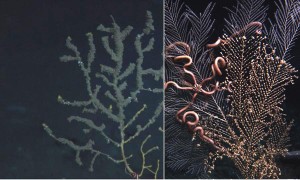http://soundwaves.usgs.gov/2012/10/research3.html
Well, yeah, duh. This was the big risk all along, wasn’t it? The loss of biologically rich and diverse habitats? Hate to say I said so…….. DV
By Rachel Pawlitz
Sept. / Oct. 2012
Nearly 2 years after the Deepwater Horizon oil spill, the meticulous, long-term efforts of scientists finally yielded the official results: the brown, wilted, dying corals found at Mississippi Canyon lease block 294 were indeed damaged by a plume of oil from the spill. For many, it seemed a foregone conclusion. What else could brown gunk (flocculent matter, if you’re a scientist) covering damaged corals 7 miles from the Deepwater Horizon drill site be, if not oil from the spill? Yet, to this team of scientists, it was worth taking a close look at the evidence with two-dimensional gas chromatography, sediment cores, coral samples, and mosaic imagery. Why? Because so much was at stake.
To understand the damage in the deep, the scientists had to start by understanding what was down there before the spill. To support that mission, enter U.S. Geological Survey (USGS) research benthic ecologist Amanda Demopoulos (http://profile.usgs.gov/ademopoulos), who studies life on the seafloor to describe what types of organisms typically live together in deep-sea communities. Her work involves digging sediment cores from the ocean bottom and sorting through the many tiny life forms found there. (For example, see “Scientists Cruise Deep Into Coral Ecosystems,” Sound Waves, December 2009.)
In addition to deep-sea coral ecosystems, Demopoulos studies communities in parts of the Gulf where oil naturally seeps up from the seafloor and is in fact a wellspring of life, not a source of damage. Chemosynthetic ecosystems-the ones where food webs are based on chemicals rather than sunlight-tend to host different life forms, such as tubeworms.
Demopoulos was on the November 2010 research expedition that first discovered the damaged corals. Led by biology professor Charles Fisher of the Pennsylvania State University (http://bio.psu.edu/directory/crf2) and funded by the Bureau of Ocean and Energy Management (BOEM) and the National Oceanographic and Atmospheric Administration (NOAA), the expedition’s goal was to build a scientific understanding of the various undersea ecosystems. It was part of a decades-long collaborative effort among federal and university scientists to explore deep-sea ecosystems in order to provide sound baseline information for management decisions about how to best balance natural-resource use with protection. Demopoulos recalled watching the first images from the damaged site come in from a remotely operated vehicle (ROV).
“When we were watching the ROV video in the lab, I looked up at the video screen, and it looked starkly different from anything we’d ever seen before,” Demopoulos said. “The corals were all dark grey and lumped over, and it was clear these animals were not healthy. We’d seen dead coral, but this was so different, we immediately knew it was worth investigating further. When we got closer, there didn’t seem to be any secondary colonization, as we’d seen in the past on dead coral.”
The fact that no new animals, such as barnacles or hydroids, had begun to attach and grow on the dead corals suggested that the coral deaths had been recent, noted Demopoulos. This process, known as secondary colonization, is commonly observed on dead corals but takes time to occur.
In December 2010, barely a month after the discovery of the damaged coral, Fisher led a followup expedition to further examine the damaged corals, supported by a special National Science Foundation RAPID grant. Fisher, along with assistant professor of chemistry Helen White of Haverford College (http://www.haverford.edu/faculty/hwhite), directed the coral-damage assessment in collaboration with scientists from Woods Hole Oceanographic Institution, Temple University, the USGS, and the BOEM. On the basis of her expertise with sediment samples, Demopoulos worked with White and Fisher to design the best approach for assessing the corals at the Mississippi Canyon lease block 294 for the presence of oil and the extent of damage.
“The challenge we faced in this study was piecing together what happened from multiple lines of evidence, because no one was sitting on the seafloor when the plume went by. The corals were the only witness,” said Demopoulos. “We had to consider the proximity to the Deepwater Horizon site and the fact that a deep-water plume had recently passed over the site, then closely examine the corals for tissue damage and signs of stress, such as the presence of mucus, and of course, the chemical signature of the oil. It was truly an interdisciplinary effort.”
Demopoulos pointed out that the cumulative knowledge about deep-sea communities from previous expeditions provided the baseline for scientifically assessing what they saw at the site. “This is but one site in the Gulf of Mexico,” she said, “but it has shown how important it was for us to have a frame of reference as to what a healthy deep-sea coral ecosystem looks like. We are still trying to understand the extent to which this is occurring elsewhere in the Gulf of Mexico.”
The results of the scientists’ efforts were published online in March 2012 in the Proceedings of the National Academy of Sciences of the United States of America (PNAS) at http://dx.doi.org/10.1073/pnas.1118029109. Additional information about the study is posted at http://science.psu.edu/news-and-events/2012-news/Fisher3-2012.
Above: Normal coral with some dead skeletal material covered by typical secondary colonization (right), in comparison with wilting, dying coral covered with oil-plume debris (left). Also affected were brittlestars, seen climbing in the healthy coral. Image courtesy of Lophelia II 2010 expedition, NOAA Office of Ocean Exploration and Research (OER) and BOEM. [larger version]
Above: Amanda Demopoulos sorts and identifies animals in a sieved sample. Image courtesy of Lophelia II 2009: Deepwater Coral Expedition: Reefs, Rigs and Wrecks. [larger version]
Above: Damaged coral with brittlestar climbing through it. Image courtesy of Lophelia II 2010 expedition, NOAA OER and BOEM. [larger version]
[Modified from USGS Science Pick at http://www.usgs.gov/blogs/features/usgs_science_pick/corals-damaged-by-deepwater-horizon/.]
Special thanks to Richard Charter
